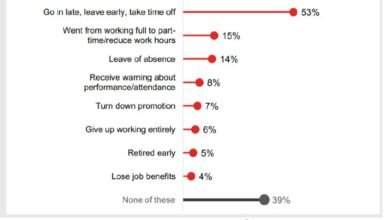
By | Charlie Fletcher
It’s no secret that digital technology has enhanced our lives in myriad ways. In the workplace, it has improved our ability to communicate with colleagues and customers alike and provides tools for efficiency. The primary workforce of Millennials and the rising Gen Z have largely grown up as digital natives. As such, their comfort and dexterity with digital devices often help them to innovate.
That said, we’re all too aware today of how this prevalence of advanced technology can disrupt our lives. The saturation of screens in almost every aspect of our existence can make it feel as though we’re unable to switch off from the digital world. We also find that such easy access to connected devices can be disruptive to our activities at work — whether we’re in an office or working remotely.
So how can we more effectively coexist with our glowing rectangles, both large and small? What strategies and policies can business leaders implement that can make an impact on productivity?
Smartphone Use
One of the most common screens in our work and home lives is the one on our smartphones. It is the most accessible form of technology that it’s predicted 72% of people will access the internet just by their smartphones by 2025. However, its portability and ease of use can also make it a problem in the office; one study found that employees spent an average of 56 minutes per working day undertaking personal activities on their cellphones. That works out to about 14% of the working week being frittered away on personal devices — that’s a significant form of leakage.
So is the solution to place a blanket ban on smartphones while at work? Almost certainly not. This is unlikely to be practical in contemporary working environments, and you also run the risk of treating the responsible adults you work with as though they are children whose behavior needs to be policed. However, it can be useful to limit the locations smartphones can be used to break areas. But be sure to back this with legitimate reasons for the restrictions: the potential for inadvertent leaks of customer data, and vulnerability for breaches of security protocols.
Creating clear policies and guidance on personal phone use can also be a way to improve employee wellness. Smartphone use has become problematic, emerging for some as an addiction that requires counseling, particularly among younger generations. Among the warning signs for addiction is an inability to monitor time spent on the phone and continued usage despite a negative impact upon their careers. The majority of employees are unlikely to experience full-blown addiction to their smartphones. However, it’s still important to provide literature about how overuse can affect employees’ mental health. This can be coupled with practical guidance on how to manage their smartphone activities in line with company policies.
Browsing Activity
It’s one thing to implement strategies to tackle the problems surrounding portable devices such as smartphones, tablets, and smartwatches. These are small items that can be taken out of the equation relatively simply. It can be another matter entirely when addressing laptop and desktop computers that employees may well be glued to throughout the day. It can be all too easy for even the best of us to become distracted by opening a browser to check out the news, social media, or — let’s face it — cat videos.
So how can business leaders best approach minimizing unproductive browsing?
- Don’t be a tyrant. Banning personal activity entirely is both unnecessary and potentially combative. There are going to be times that employees will need to undertake personal tasks during work hours, and some casual browsing can help to relieve the pressures of the day. Communicate clearly to employees to what extent personal use is acceptable.
- Use throttling. Let employees know that while you’re not averse to personal browsing, bandwidth throttling may be implemented on sites that aren’t necessary for work use. Frame this from the perspective that it’s important to leverage the company’s resources correctly, as this can have an impact not just on profit margins, but bonuses and pay rises too. Employees will also be less likely to frequently visit sites that are slow to load.
- Communicate legal factors. Empowering employees with knowledge is a respectful approach to addressing browsing behavior. Provide training that demonstrates that unauthorized use can leave companies vulnerable to harmful material. Show how employees using work devices for personal use may not be protected by the same rights to privacy that they have at home and that using company systems to send messages may even leave them in breach of data protection policies. Overall, give employees the tools and knowledge to act responsibly.
Environmental Factors
The saturation of screens all around us can indeed be a recipe for distraction. However, it is neither productive nor accurate to blame the devices or indeed their users entirely. Rather, it’s just as important for business leaders to examine whether the workplace itself is conducive to preventing distractions and encourage productivity.
This should begin with a closer look at employees’ workdays. Are there ways in which their schedule can include regular opportunities to spend time away from screens, undertaking work that sees them personally interacting with both colleagues and customers without a device? Introduce a policy of no devices during team meetings, bring a sense of physical activity into a primarily digital environment.
The workplace itself should also minimize the reliance upon screens. Provide open-plan layouts to encourage the collaboration and verbal communication of colleagues. Introduce comfortable break spaces that have no televisions or computers, but rather light color schemes, and furniture arrangement that is geared toward conversation. This can be an important aspect of self care, which can also be a factor in improving productivity. These can also help support habits that reinforce the idea that screens at work are for very specific tasks, rather than for distraction and relaxation.
Conclusion
Screens are one of the more prevalent presences in our lives today. While they can be effective tools, they can also serve to hamper productivity. By empowering employees to effectively curb unnecessary personal smartphone and browsing behavior, and implementing a less technology-led working environment, business leaders can help to promote ongoing productivity.






